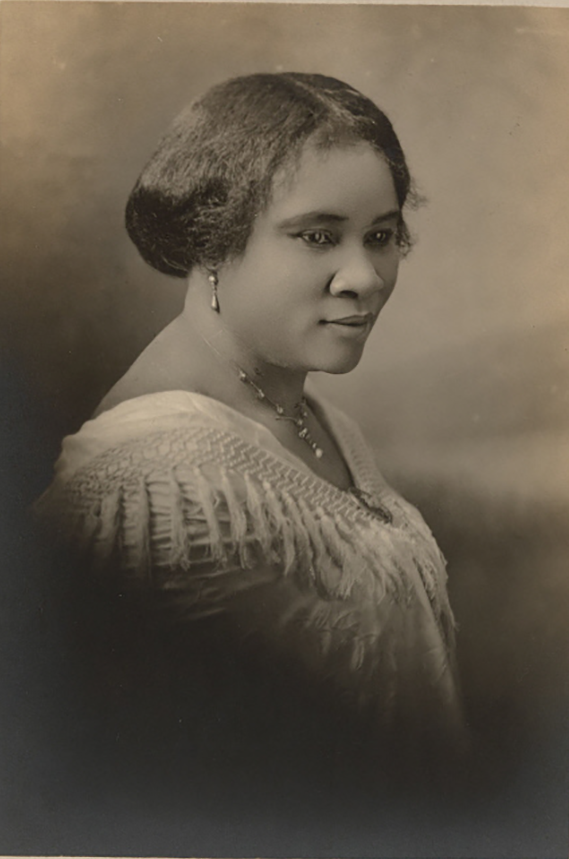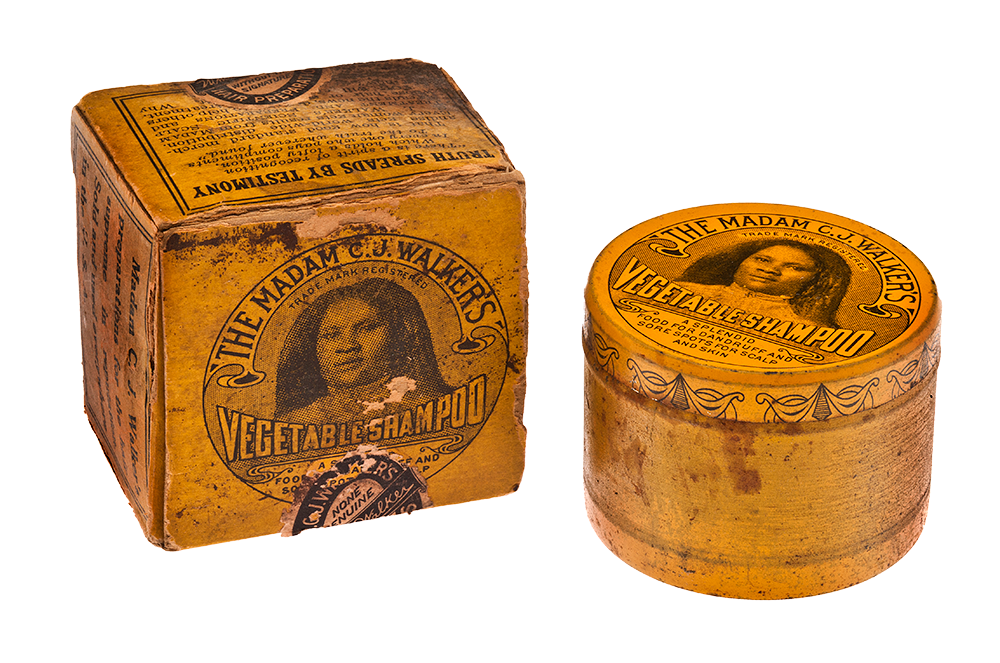Sarah Breedlove was born on December 23, 1867 in Delta, Louisiana. Sarah’s parents and her four older siblings had been enslaved on a cotton plantation until the end of the Civil War. Sarah was the first member of her family to be born into freedom. The family lived and worked together as sharecroppers.
Sarah learned to look out for herself at a young age. She had lost both of her parents by the time she was seven years old, and lived with her older sister. Later in life, Sarah would describe her sister’s husband as a cruel man who may have been abusive to her and who forced her to make money picking cotton and doing laundry. At the age of 14, Sarah ran away from home and married a man named Moses McWilliams. Before her seventeenth birthday, she gave birth to her only child, a daughter named Lelia. Three years later, Moses died and Sarah was a young, widowed mother.
Sarah and her daughter moved to St. Louis so that they could live near her three older brothers, all of whom had left the South at a young age to escape racial violence and find jobs. Sarah worked as a laundress for $1.50 a day and went to night school when she was able. In 1906, she married Charles Joseph “C.J.” Walker.
Throughout her life, Sarah had struggled with hair loss. It was likely caused by poor nutrition and stress. Like most Black women of the time, Sarah used harsh soap and heavy oil and grease on her head, which would have only made her condition worse. Although new technology had led to the expansion of the beauty industry in the late 1800s, most products were designed for and sold to white women.
Sarah took a job with a small company selling beauty products for Black women when she was in her early 20s. At the same time, she experimented at home with her own formulas. She worked to create healthy products that softened her hair and eased her irritated scalp. Little by little, Sarah’s hair began to grow—as did her idea for a business of her own.
Once Sarah had created products that she felt worked well for her, she began to sell them. She renamed herself Madam C.J. Walker and began to advertise her products in Black publications and sold them through a mail order system. She was so happy with how her hair had grown that she put pictures of herself on the packaging. She held lectures and demonstrations of what she called the “Walker Method”: washing hair with gentle shampoo, brushing hair, massaging the scalp, and then treating hair with a healing pomade. By 1910, business was booming. She moved to Indianapolis to build a factory and establish a permanent company headquarters.
When Madam Walker was expanding her company, beauty in the Black community was a controversial issue. White racists pointed to Black hair as evidence that Black people were inferior. They argued that Black women who could not smooth out their kinky hair were unclean and messy. For many Black women, using beauty products to smooth out their hair was a way of fighting back against racism and demonstrating their equality to white women. On the other hand, some advocates believed that by mimicking white hair fashions, Black women were catering to racism. Although Madam Walker did sell products that helped straighten and smooth hair, she argued that her products were also about health. Because she had personally struggled with hair and scalp issues, she promoted healthy hair over a certain style of hair.
Madam Walker also worked to rise above the controversy by using her business to empower Black women financially. She founded several beauty training schools and employed hundreds of women across the country to serve as Walker Agents. These saleswomen were trained in the Walker Method and were the face of the Walker brand. Madam Walker organized national conventions for agents, where they could share selling strategies, learn about new products, and receive rewards for outstanding sales. For many women, being a Walker Agent and working for a Black woman-owned business was a welcome alternative to low-paying domestic work.
In 1913, Madam Walker and Charles Walker divorced. Madam Walker focused on extending her company to the Caribbean and Latin America. In 1916, she followed her daughter to New York City and moved into a grand townhouse in Harlem. Although she continued to run the business, she allowed employees to handle the day-to-day operations while she focused her time on new projects.
Madam Walker was the first self-made Black female millionaire in America.
As Madam Walker’s business grew, so did her wealth. In addition to her Harlem townhouse, she also owned a Model T Ford and had plans to build a mansion in upstate New York called Villa Lewaro. (She created the name using letters from her beloved daughter’s name: Lelia Walker Robinson.) But Madam Walker did not spend all of her money on luxury. She was as famous for her philanthropy as she was for her beauty business. Madam Walker donated money to scholarships, homes for the elderly, anti-lynching efforts, and other initiatives within the local and national Black community. She was committed to helping Black men and women escape poverty, just as she had.
Madam Walker died from complications of high blood pressure on May 25, 1919 at the age of 51. At the time of her death, it was estimated that her estate was worth $1 to $2 million (the equivalent of $14 to $30 million in 2018). She was the first self-made Black female millionaire in America. Her daughter, Lelia, continued in her mother’s footsteps. She took over the still-growing company and used her mother’s fortune to support artists, writers, and other luminaries of the Harlem Renaissance.
Vocabulary
- enslaved: To be held as a slave.
- luminaries: Impressive and famous individuals.
- lynching: The illegal execution of a person by a mob.
- philanthropy: The practice of donating large sums of money to charity.
- pomade: Hair product.
- sharecropper: A farmer who lives and works on land owned by someone else in exchange for a share of the profits.
Discussion Questions
- How might Madam Walker’s adult life and career have been shaped by the challenges she faced as a young girl in Louisiana?
- How did Madam Walker give back to the Black community and promote economic independence for Black women and men?
- Why were beauty products like Madam Walker’s controversial? And what does this tell us about the challenges Black women faced in this era?
Suggested Activities
- Lead students through an analysis of the vegetable shampoo tin and box, which include portraits of Madam Walker. What does this pair of objects tell us about Madam Walker’s products and approach to marketing? How does this object enhance our understanding of her life story and Black beauty culture at the turn-of-the-century?
- Consider the many ways Black women fought to legitimize their citizenship and fight discrimination by studying Madam Walker’s life story alongside Fannie Barrier Williams’s article in the Chicago Defender; Adella Hunt Logan’s case for suffrage in The Crisis; Addie Hunton and Kathryn Johnson’s account of Black war work; the photograph of the 1917 silent march; the photograph of Atlanta Neighborhood Union; and the life stories of Mary Church Terrell, Ida B. Wells, and Maggie Walker.
- Study the intergenerational impact of slavery and Black citizens’ ability to overcome it. Combine Madam Walker’s life story with the life stories of Maggie Walker, Ida B. Wells, and Mary Church Terrell, all of whom had parents who were formerly enslaved.
- Connect Madam Walker’s life story to contemporary debates over discrimination against Black women because of their hair. For example, explore New York City’s February 2019 ban against discrimination based on hair and invite students to discuss how this relates to the debates Madam Walker and other women of the Progressive Era had about the impact of their chosen hairstles. Download a PDF of the full guidelines here.
Themes
SCIENCE, TECHNOLOGY, AND MEDICINE; IMMIGRATION, MIGRATION, AND SETTLEMENT; ACTIVISM AND SOCIAL CHANGE; AMERICAN CULTURE
New-York Historical Society Curriculum Library Connections
- For more resources relating to Black women in the nineteenth and early twentieth centuries, see Black Citizenship in the Age of Jim Crow.








